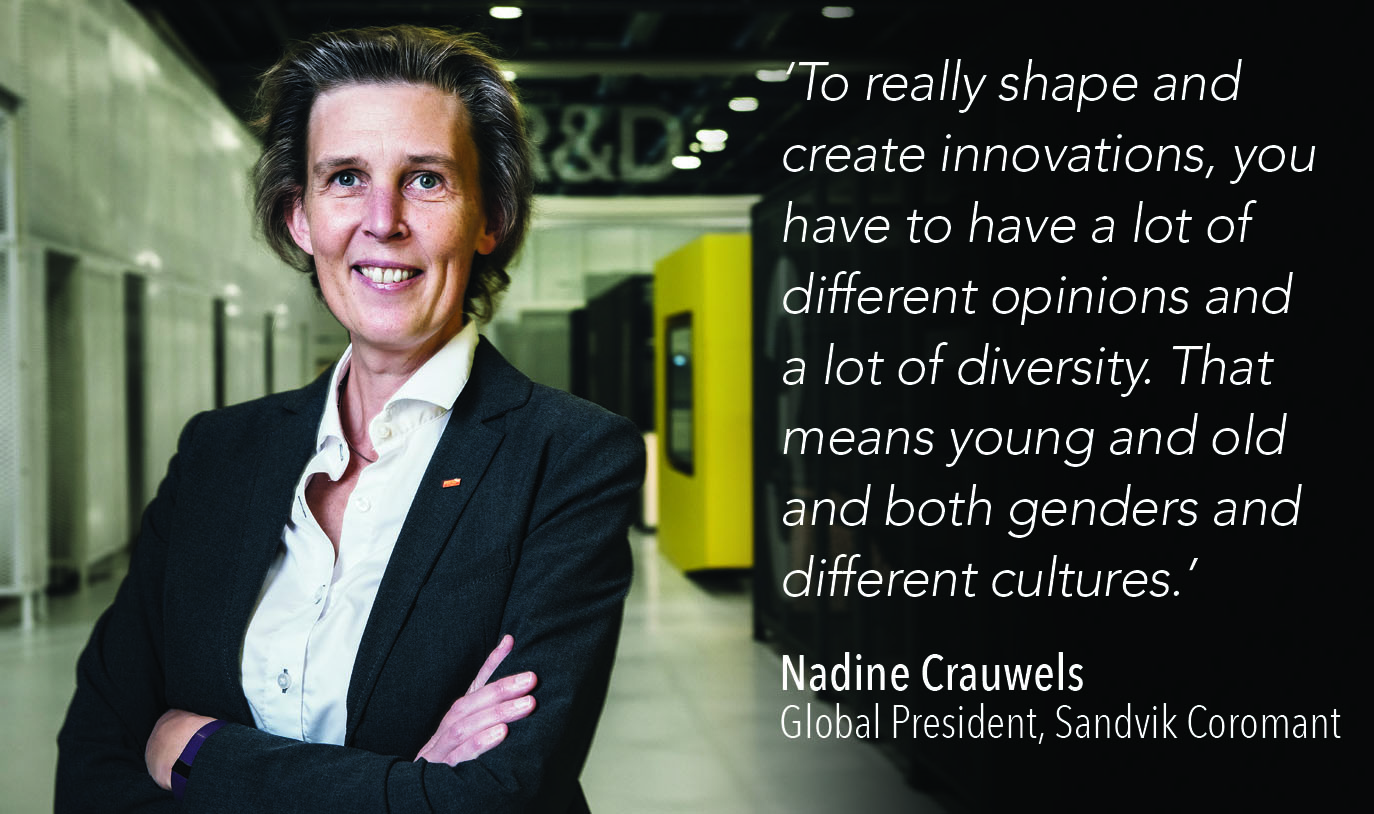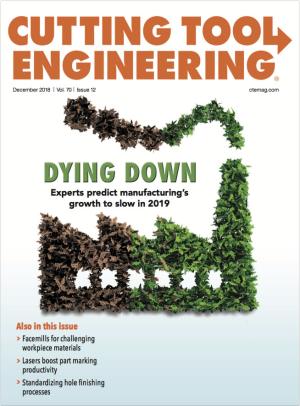After being at AB Sandvik Coromant, Sandviken, Sweden, for 17 years, Nadine Crauwels was appointed global president of the cutting tool manufacturer in May 2017. She has had roles in sales, product management, product introduction, custom tools and strategic relations.
In an interview with CTE Editor Alan Richter at IMTS 2018, Crauwels discussed the advancements being made in cutting tool technology, manufacturing digitization, the global market for cutting tools, employee diversification and the opportunities in the manufacturing industry for everyone interested in pursuing them.
Cutting Tool Engineering: How is Sandvik Coromant pushing itself out of its comfort zone?
Nadine Crauwels: If you look back X number of years ago, Sandvik Coromant was really a company that had a lot of inserts and tools and know-how and knowledge. Now, with our CoroPlus platform, you have extra efficiencies and
productivity. It’s another leap, because you get the digitization and the data that comes out. It makes the industry much more attractive in one way, but you also enable customers to significantly reduce the waste that they have: waste of time, waste of energy, waste of material. That’s where we push the boundaries so that we can say we don’t want to stay only in the machining area. We want to do the pre-machining and reduce the waste during the design and the planning.

Image courtesy of Sandvik Coromant
CTE: Does Sandvik Coromant have a contingency plan if or when cutting tools are no longer needed to produce parts?
Crauwels: I don’t think it’ll happen soon where there is no need for cutting tools. You’ll see shifts happening as to what is really important, such as round tools becoming more important, but cutting tools will not disappear so fast. There will be new technologies and new techniques, but material cutting capabilities and processes won’t disappear.
CTE: Is the market for cutting tool manufacturers growing?
Crauwels: The market is growing in all regions. If you would look at America, Europe and Asia, all areas are growing. If you slice it in another direction and look into aerospace, automotive or oil and gas, all segments are also doing really well. At the same time, when the market is growing, customers want to grow, but they also want to be very clear on cost control. That makes it very interesting to work with these two aspects: to help customers grow in the sense of what they need to deliver more pieces but also to bring the cost down of their processes. This is done with the help of digital solutions and methods. It’s a huge opportunity. That is one thing that has been changing. In good times, customers want to produce more, and in bad times, they want to reduce costs. Now, more and more, they want to do both.
CTE: What do you recommend to women who are looking to become cutting tool engineers?
Crauwels: Just jump in and do it. There is no reason why somebody shouldn’t try. The metalcutting industry is in a changing role. There are so many opportunities that are related to digitization, which makes the industry much more
attractive and provides much more value. The contribution from diversity is extremely important. Having different opinions and coming together will create innovations. I would say don’t hesitate. It is an extraordinary opportunity for those who want it.
CTE: How can manufacturers attract younger people?
Crauwels: We want to understand the younger generation’s values and what they want out of the job, because we need to understand what kind of environment they want to work in. A lot of what they tell us is that it is extremely important to contribute to something. They want to be able to be part of something that delivers a value and really has a purpose. What is the purpose? Why are we here? What can we do? How can we turn technology into human progress? That is much more convincing for the next generation. It’s a strong feeling of wanting to be part of something bigger, and that’s also where our vision comes in shaping the future together. To really shape and create innovations, you have to have a lot of different opinions and a lot of diversity. That means young and old and both genders and different cultures. Because if we want to stay ahead of our competition, if we want to differentiate, we need to overcome those challenges. Otherwise, we will not be able to take the next leap on innovations.
CTE: Do manufacturers need to do to become ready for Industry 4.0 and remain competitive?
Crauwels: The way to successfully move forward is to make Industry 4.0 concrete because everybody talks about Industry 4.0, but what does it really mean? What does the customer need to do? What can I start doing tomorrow to take a step forward, and how can I build on this one step to take the next step? There has to be guidance and working together with customers to take those different steps. That’s how we, along with the CoroPlus platform and all of its different parts, create an option for customers to say, “OK, I see my first step.” You get together with the customer to create a journey and digitize the whole industry step by step.
Related Glossary Terms
- metalcutting ( material cutting)
metalcutting ( material cutting)
Any machining process used to part metal or other material or give a workpiece a new configuration. Conventionally applies to machining operations in which a cutting tool mechanically removes material in the form of chips; applies to any process in which metal or material is removed to create new shapes. See metalforming.
- metalcutting ( material cutting)2
metalcutting ( material cutting)
Any machining process used to part metal or other material or give a workpiece a new configuration. Conventionally applies to machining operations in which a cutting tool mechanically removes material in the form of chips; applies to any process in which metal or material is removed to create new shapes. See metalforming.
- shaping
shaping
Using a shaper primarily to produce flat surfaces in horizontal, vertical or angular planes. It can also include the machining of curved surfaces, helixes, serrations and special work involving odd and irregular shapes. Often used for prototype or short-run manufacturing to eliminate the need for expensive special tooling or processes.


